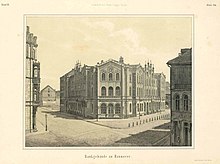Hannoversche Bank

The Hannoversche Bank was from 1856 to 1920, a credit institution with headquarters in Hannover . The Hannoversche Bank was originally a central bank and became part of the Deutsche Bank .
history

tinted lithograph by Julius Giere , around 1858; Journal of the Architects and Engineers Association in Hanover

Postcard number 299 from Karl F. Wunder

Graphic by Änne Koken in the Illustrirten Zeitung of April 20, 1911

As in the other German states, during the early days of the 19th century, Hanover wanted its own central bank. The bank was supposed to cover the increasing demand for cash, which arose from the onset of industrialization and the accession of the Kingdom of Hanover to the German Customs Union in 1854 .
With the law of the Hanoverian Ministry of the Interior of 1847, the Magistrate of the City of Hanover was authorized to issue receipts for 1 thaler and 5 thaler for a total of 200,000 thalers. However, since 5,000 thalers were withdrawn from these as repayment, this could not cover the need.
In 1856 the Hannoversche Bank was founded as a private bank and received the right to issue notes. In 1857, notes worth 10, 20, 50 and 100 thalers were issued.
With the annexation of the Kingdom of Hanover by Prussia in 1866, the bank found itself in a difficult position. Although her banknote privilege continued to apply, the banknotes were not on an equal footing with those of the Prussian Bank .
With the establishment of the empire in 1871, the member states of the empire lost their legislative rights with regard to the monetary system. The Reichsbank was not given a monopoly on the issue of banknotes ; the existing central banks retained the right to issue banknotes to the extent specified in the Annex to Section 9 of the Banking Act of March 14, 1875. A quota of banknotes worth 6,000,000 marks was planned for the Hannoversche Bank .
In 1871 a note for 10 thalers and (after the currency reform ) one for 100 marks was issued. However, the conditions under which the bank could use its right to issue notes were so restrictive that Hannoversche Bank voluntarily waived the right to issue notes in 1889. In 1891 the bank's last note expired. The bank continued to exist as a commercial bank and was merged with Deutsche Bank in 1920. Due to the lack of space, Karl Börgemann built a new building on Georgsplatz in 1900 .
Personalities
- From 1869 the Senator Louis Meyer was chairman of the board of directors of the Hannoversche Bank.
Literature (selection)
- Historical Society of Deutsche Bank (Ed.): The Deutsche Bank in Hanover , number 4777 in the Piper series , original edition, Munich; Zurich: Piper, 2006, ISBN 3-492-24777-6
- Friedrich Geigant: Hanoverian paper money in the 19th century. Loan cashier notes, municipal notes and notes from the Hannoversche Bank. In: Hannoversche Geschichtsblätter , New Series 61 (2007), pp. 5-69
- Waldemar R. Röhrbein : Hannoversche Bank In: Klaus Mlynek, Waldemar R. Röhrbein (ed.) U. a .: City Lexicon Hanover . From the beginning to the present. Schlütersche, Hannover 2009, ISBN 978-3-89993-662-9 , p. 258.
Web links
Individual evidence
- ^ Banking Act of March 14, 1875 on Wikisource
- ^ Albert Pick: Paper money . 1967, pages 190-191
- ^ Klaus Mlynek : MEYER, (8) Louis. In: Dirk Böttcher , Klaus Mlynek, Waldemar R. Röhrbein, Hugo Thielen : Hannoversches Biographisches Lexikon . From the beginning to the present. Schlütersche, Hannover 2002, ISBN 3-87706-706-9 , p. 253.
Coordinates: 52 ° 22 ′ 16.7 " N , 9 ° 44 ′ 30.7" E
